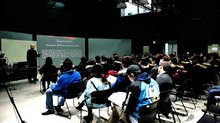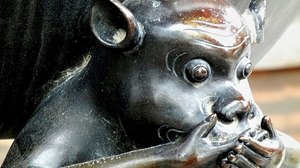Blog Post
Breaking Bad meets Star Trek
During the season premiere of Breaking Bad's final season, the always hilarious character Badger describes his Star Trek script to Skinny Pete. Less than 24 hours after the premiere, someone has created an animated version of the scene.
Zammarchi animates Johnny Cash ditty.
Julie Zammarchi is an American indie animator best known for her films Ape (1992) and beautiful The Passenger (2009). I stumbled upon a recentish piece short she did using Johnny Cash's 25 Minutes To Go.
Life vs. Afterlife Part 2
Having traveled and lived in countries representative of truly diverse ideological, political, economic, social, geographic and otherwise distinctive settings, the issuing realities are dawning on me, and in the reflective process also are becoming uncomfortably clear to me.
Life vs. Afterlife Part 1
This much delayed episode comes to you all the way from China, where I am now, invited here as a Professor & KoGuan Chair of Digital Arts & Design @ Peking University.
Creative Workshops on “Gravity Free & Reality Independent” Ideation: Part 1
I shall attempt to express why creative workshops are so imperative, impactful and, at least in my personal conclusion, simply fundamental.
The Best of SIGGRAPH Electronic Theatre 2012
Today it takes an experienced eye to differentiate a synthetic actor from a real live one. It is amazing. It's a genuine achievement. So what is wrong with this?
Encounter with Peru Part 2 - Non-Human Storytellers
And so, while this series of blogs is not really related to animation per say, they are truly inspired by the power of imagination open-mindedness is capable of unveiling to us all.
Crash Landing – Encounter with Reality Part 2
And so it seems that humanity is loosing appreciation and benefits of simple and pure nothingness, of silence and calm, which come with not being under pressure to talk, to respond, to converse, react, but instead to think and feel, digest and reflect. Why?
Crash Landing – Encounter with Reality Part 1
Spending time, living in and discovering a foreign country is exciting and enlightening to me. So, on this particular occasion returning to the “New World” proved to be more of a sobering experience than usual. As you read on, you will realize that it actually tested and contested my own tolerance and open mindedness.
The New World
This reflection is devoted to the spirit of imagination, innovation, ideation and invention: how these precious values are reflected through the architectural realizations of the country called the “New World”. In my humble perception, something has gotten lost in translation. Are we slipping, losing it?
Imagination Part 6: Finale
How do we anticipate the future and what will be the role for artistic individuals in its shaping? What kind of creative canvases will the future offer us? How will technology, sciences and their fusion with arts impact our creative powers? How will imagination fit into this brave new world?
Imagination Part 5
From our very origin humanity has been striving to unravel and unveil the grand design, the very scheme by which this vast Universe, and all within it, works, and the ingenuity by which it all begun, as well as where it is all evolving to. In this pursuit, as history has shown, we have wasted a lot of time seeing ourselves as unique, the center of it all, the ones around whom everything revolves.
Imagination Part 4
I challenge students to expose themselves, not physically but spiritually. I call upon them to “take the condom off their head”, have an unsafe idea, for life is too short and precious for following in someone else’s steps, make your own path through an untapped space.
Imagination Part 3
To many the “system” is the symbol of oppression, the foe to resist in almost any cause. To us, not understanding something is a challenge that motivates and inspires, it ignites our imagination, makes us restless until, if fortunate, we arrive at an answer, a climax, whether right or not.
Imagination Part 2
These days, when technology plays such a significant role in all aspects of our lives, and in much of what we do, there is a strong relationship between “IT” and our imagination: when they are not in balance, technology itself can overshadow imagination and seemingly become the ultimate answer to all. But when they are, technology empowers us, acting as our “magic wand”.
Imagination Part 1
To share ideals and bring about meaningful transformations one needs a voice. Coming from a country where artists were the heralds of freedom and the voices for change against an oppressive system shaped by single-minded and intolerant ideology and resulting government, I have found mine through the power of imagination.
Encounter with Japan Part 3
Now, having observed Japanese society, the way it was taught to control their emotional and physical demeanor, I am un-startled by their adamantly unshaken, orderly, ongoing trust in authorities. It leads to a polite, restrained, reverently subdued reaction to what ensued due the corporate negligence, and a secretive, cunning cover up that continues to define what is being done to them.
Encounter With Japan Part 2
As I reflected in my previous blog, Japanese are true perfectionists, in all they do. Thus, when it comes to political correctness, over centuries, and elected isolation from the external world, they turned it into an art form, a nature, but at what cost? Bowing projects a wonderfully charming sense of politeness and respect, but it does not end on just one bow, it goes on, and on. It is very carefully and skillfully choreographed and, as such, not spontaneous.
Encounter with Japan Part 1
"Are you insane?” "Have you lost your mind?" "Are you not afraid?" "Don't you realize this is the worse time to go there?" This is just a sampling of the polite examples of reactions and comments my plans for a trip to Japan had triggered. And yet, based on my own life’s journey, I understood early on that, sometimes the worse time could be the best, the most raw, sincere, revealing and insightful.
How to Get a “God’s-Eye View” of Your Story in Microsoft Excel
The reason I use Excel to develop story structure is based on a writing principle I discovered years ago. I call it getting a God’s-Eye View of the story. I realized that by writing my outline beats in a normal word processing program it took screen after screen to go through my scenes. So while I was looking at one portion of my story, the rest of the story was out of sight. And as they say, “Out of sight, out of mind”. But when I write I want all of my story in mind. And here’s how I do it...

























































